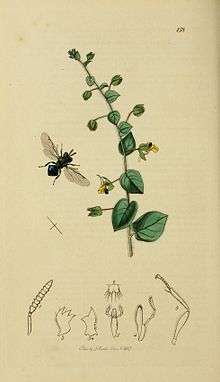Perilampidae
| Perilampidae | |
|---|---|
 | |
| Perilampus ruficornis illustration from British Entomology | |
| Scientific classification | |
| Kingdom: | Animalia |
| Phylum: | Arthropoda |
| Class: | Insecta |
| Order: | Hymenoptera |
| Suborder: | Apocrita |
| Superfamily: | Chalcidoidea |
| Family: | Perilampidae Latreille, 1809 |
| Subfamilies | |
|
Chrysolampinae | |
| Diversity | |
| 3 subfamilies 15 genera c. 270 species | |
The Perilampidae are a small family within the Chalcidoidea, composed mostly of hyperparasitoids. The family is closely related to the Eucharitidae, and the eucharitids appear to have evolved from within the Perilampidae, thus rendering the family paraphyletic (if the two families are joined in the future, the name with precedence is Eucharitidae). As presently defined, 15 genera and about 270 species are described worldwide. They are often brilliantly metallic (especially blue or green), with robust mesosomae and a small, triangular metasomae (swollen and bulbous in the Philomidinae). They are generally very strongly sculptured. The prothorax is typically very broad and disc-like, and the labrum is multidigitate, a feature shared with the Eucharitidae.
Another feature shared by the Eucharitidae and Perilampidae is the first-instar larvae are called "planidia" and are responsible for gaining access to the host, rather than the egg-laying females. Those species which are hyperparasitoids burrow into a secondary host's body and seek out endoparasitoid larvae, such as tachinid flies or ichneumonoid wasps, and attack them.